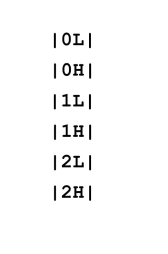Knowledge of where animals forage for food is essential for effective wildlifemanagement and conservation. The data below are foraging heights (in m) for asample of Mountain Chickadees. The data are taken from two different species of firtrees: the Douglas fir and the White fir.  (a) Display these data using a comparative (back-to-back) stem-and-leaf plot. Usethe stems shown below, and be sure to include all information needed to comparethe two distributions.
(a) Display these data using a comparative (back-to-back) stem-and-leaf plot. Usethe stems shown below, and be sure to include all information needed to comparethe two distributions.  (b) Compare the distributions in part (a). What differences and similarities do youobserve in the two distributions?
(b) Compare the distributions in part (a). What differences and similarities do youobserve in the two distributions?
(c) When Mountain Chicadees are sampled to assess their health, they are captured inmist-nets, which are set to capture the birds at different heights. The mist nets areabout 2 meters high, and directions must be given to the persons who set up thenests so that the mist-nets are positioned to capture the most birds. Based on thedata from part (a) and your display in part (b), write a short paragraph describingthe appropriate mist-net height in a forest region of Douglas firs and for a forestregion of White firs.
Correct Answer:
Verified
Q2: When using histograms to compare groups of
Q4: A numerical variable is continuous if it's
Q5: The stem-and-leaf plot below displays the weights
Q6: In a scatter plot, both the horizontal
Q8: If the upper tail of a distribution
Q8: An outlier is a data value that
Q9: A univariate data set must contain numerical,
Q10: A time series plot is a graph
Q11: The article "New Rules Would Protect Students"
Q12: A pie chart is most useful for
Unlock this Answer For Free Now!
View this answer and more for free by performing one of the following actions

Scan the QR code to install the App and get 2 free unlocks

Unlock quizzes for free by uploading documents